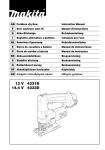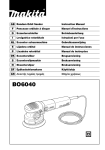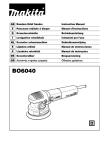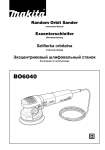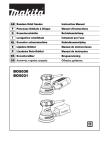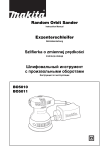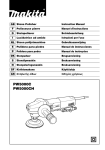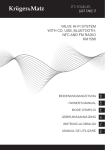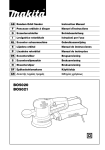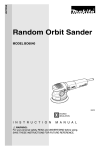Download Makita BO6040 Instruction manual
Transcript
GB Random Orbit Sander Instruction Manual F Ponceuse orbitale à disque Manuel d’instructions D Exzenterschleifer Betriebsanleitung I Levigatrice rotorbitale Istruzioni per l’uso NL Excenter schuurmachine Gebruiksaanwijzing E Lijadora orbital Manual de instrucciones P Lixadeira rotorbital Manual de instruções DK Excentersliber Brugsanvisning S Excenterslipmaskin Bruksanvisning N Eksentersliper Bruksanvisning SF Epäkeskohiomakone Käyttöohje GR Λειαvτής τυχαίας τροχιάς Οδηγίες χρήσεως BO6040 1 2 1 2 3 5 6 4 3 4 8 9 7 5 6 13 12 11 8 10 7 2 8 14 9 10 16 15 11 12 17 13 3 ENGLISH Explanation of general view 1 2 3 4 5 6 Abrasive disc Side grip Screw Pad Hex wrench Switch lever 7 8 9 10 11 12 Speed adjusting dial Change knob Roto-orbit mode Random orbit mode Dust outlet Cuff 13 14 15 16 17 Hose Joint Sponge pad Felt pad Wool pad SPECIFICATIONS 9. Model BO6040 Pad diameter ...................................................... 150 mm Abrasive disc diameter ....................................... 150 mm Orbits per minute ........................................ 1,600 – 5,800 Overall length ..................................................... 316 mm Net weight ............................................................. 2.7 kg SAVE THESE INSTRUCTIONS. • Due to our continuing program of research and development, the specifications herein are subject to change without notice. • Note: Specifications may differ from country to country. Power supply The tool should be connected only to a power supply of the same voltage as indicated on the nameplate, and can only be operated on single-phase AC supply. They are double-insulated in accordance with European Standard and can, therefore, also be used from sockets without earth wire. Safety hints For your own safety, please refer to the enclosed safety instructions. SPECIFIC SAFETY RULES GEB021-1 DO NOT let comfort or familiarity with product (gained from repeated use) replace strict adherence to sander safety rules. If you use this tool unsafely or incorrectly, you can suffer serious personal injury. 1. Hold power tools by insulated gripping surfaces when performing an operation where the cutting tool may contact hidden wiring or its own cord. Contact with a "live" wire will make exposed metal parts of the tool "live" and shock the operator. 2. Always use safety glasses or goggles. Ordinary eye or sun glasses are NOT safety glasses. 3. Hold the tool firmly. 4. Do not leave the tool running. Operate the tool only when hand-held. 5. This tool has not been waterproofed, so do not use water on the workpiece surface. 6. Ventilate your work area adequately when you perform sanding operations. 7. Some material contains chemicals which may be toxic. Take caution to prevent working dust inhalation and skin contact. Follow material supplier safety data. 8. Use of this tool to sand some products, paints and wood could expose user to dust containing hazardous substances. Use appropriate respiratory protection. 4 Be sure that there are no cracks or breakage on the pad before use. Cracks or breakage may cause a personal injury. WARNING: MISUSE or failure to follow the safety rules stated in this instruction manual may cause serious personal injury. OPERATING INSTRUCTIONS Installing or removing abrasive disc (Fig. 1) Important: • Always be sure that the tool is switched off and unplugged before installing or removing the abrasive disc. • Always use hook-and-loop system abrasive discs. Never use pressure-sensitive abrasive discs. To install the abrasive disc, first remove all dirt or foreign matter from the pad. Then attach the abrasive disc to the pad, using the hook-and-loop system of the abrasive disc and the pad. Be careful to align the holes in the abrasive disc with those in the pad. To remove the disc from the pad, just pull up from its edge. Installing side grip (optional accessory) (Fig. 2) Remove one of the screws which secure the head cover. Screw the side grip on the tool securely. The side grip can be installed on either side of the tool. Changing pad (Fig. 3) Makita offers an extensive range of optional super soft, soft and hard pads. Remove the screw counterclockwise from the center of the base with a hex wrench. After changing the pad, tighten the screw clockwise securely. Switch action (Fig. 4) CAUTION: Before plugging in the tool, always check to see that the switch lever actuates properly and returns to the “OFF” position when the side of the switch lever is depressed. To start the tool, slide the switch lever to the “I” position. For continuous operation, depress the front of the switch lever and then slide to the “I” position as above.The switch is used in this locked-on position for continuous operation. To stop the tool from this locked-on position, slide the switch lever to the “O” position by depressing the rear of the switch lever. Speed adjusting dial (Fig. 5) The rotating speed can be changed by turning the speed adjusting dial to a given number setting from 1 to 5. Higher speed is obtained when the dial is turned in the direction of number 5. And lower speed is obtained when it is turned in the direction of number 1. Refer to the table below for the relationship between the number settings on the dial, orbits per minute and the pad rotating speed. Number Orbits per min. Roto-orbit pad rotating speed per min. 1 1,600 180 2 2,100 240 3 3,600 420 4 5,100 590 5 5,800 670 CAUTION: • If the tool is operated continuously at low speeds for a long time, the motor will get overloaded and heated up. • The speed adjusting dial can be turned only as far as 5 and back to 1. Do not force it past 5 or 1, or the speed adjusting function may no longer work. Selecting action mode (Fig. 6 & 7) Use the change knob to change the rotation mode. Roto-orbit mode is orbital action plus rotation action of pad for rough sanding and polishing. Random orbit mode is orbital action of pad for fine sanding. Rotate the change knob counterclockwise for roto-orbit mode and clockwise for random orbit mode. CAUTION: • Do not rotate the change lever when the tool is running under load. The tool will be damaged. Typical applications for sanding and polishing Sanding Use / Material Mode selection Speed control setting Pad Paintwork: Sanding Repairs (scratches, rust spots) Rough paint stripping Random Roto-orbit/Random Roto-orbit 1–3 2–3 4–5 Soft Hard Soft Plastics: Soft plastics (PVC/ABS) Hard plastics (FRP) Roto-orbit/Random Roto-orbit 1–3 1–3 Super soft/Soft Soft/Hard Woods: Softwood Hardwood Veneers Random Roto-orbit/Random Random 1–3 3–5 1–2 Super soft/Soft Soft Super Soft Metals: Non-ferrous metal (aluminum, copper) Steel Steel, rust removal Hard metal (stainless steel) Roto-orbit/Random Roto-orbit Roto-orbit Roto-orbit 1–3 3–5 4–5 4–5 Soft Soft/Hard Super soft Soft 5 Polishing Use / Material Speed control setting Mode selection Pad Applying wax Roto-orbit 2–4 Removing wax Roto-orbit 4–5 Sponge pad Felt pad Polishing Roto-orbit 4–5 Wool pad The above information is intended only as a guide. In each case, the most appropriate sanding disc grain should be determined by preliminary trials. The tool equipped with electronic function is easy to operate because of the following features. • Constant speed control Electronic speed control for obtaining constant speed. Possible to get fine finish, because the rotating speed is kept constant even under load condition. • Soft start feature Safety and soft start because of suppressed starting shock. Dust collection (optional accessory) (Fig. 8 & 9) If a Makita hose is used, you can connect the cuff to the dust outlet directly. If other hose with an inner diameter of 24 mm, attach the joint between the dust outlet and the cuff. Sanding operation (Fig. 10) CAUTION: • Never switch on the tool when it is in contact with the workpiece, it may cause an injury to operator. • Never run the tool without the abrasive disc. You may seriously damage the pad. • Never force the tool. Excessive pressure may decrease the sanding efficiency, damage the abrasive disc or shorten tool life. Turn the tool on and wait until it attains full speed. Then gently place the tool on the workpiece surface. Keep the pad flush with the workpiece and apply slight pressure on the tool. Polishing operation CAUTION: • Use only a Makita genuine sponge pad, felt pad or wool pad (optional accessories). • Always operate the tool at low speed to prevent work surfaces from heating abnormally. • Never force the tool. Excessive pressure may decrease the polishing efficiency and cause motor overload, resulting in tool malfunction. 1. Applying wax (Fig. 11) Use an optional sponge pad. Apply wax to the sponge pad or work surface. Run the tool to smooth out the wax. NOTE: First, wax a less conspicuous portion of the work surface to make sure that the tool will not scratch the surface or result in uneven waxing. 2. Removing wax (Fig. 12) Use an optional felt pad. Run the tool to remove wax. 3. Polishing (Fig. 13) Use an optional wool pad. Run the tool and apply the wool pad gently to the work surface. 6 MAINTENANCE CAUTION: Always be sure that the tool is switched off and unplugged before carrying out any work on the tool. To maintain product safety and reliability, repairs, maintenance or adjustment should be carried out by a Makita Authorized Service Center. ACCESSORIES CAUTION: These accessories or attachments are recommended for use with your Makita tool specified in this manual. The use of any other accessories or attachments might present a risk of injury to persons. Only use accessory or attachment for its stated purpose. If you need any assistance for more details regarding these accessories, ask your local Makita service center. • Hook-and-loop system abrasive disc (with pre-punched holes) Grit Use • • • • • • • • 40 60 Coarse 80 120 Medium 180 240 400 Fine Hook-and-loop system sponge pad Hook-and-loop system felt pad Hook-and-loop system wool pad Sanding cloth 150 – #100, #200, #800 for fine sanding Pad 150 (Super Soft, Soft, Hard) Side grip Joint Hex wrench NEDERLANDS Verklaring van algemene gegevens 1 2 3 4 5 6 Schuurschijf Zijhandgreep Schroef Steunschijf Zeskantsleutel Schakelaar 7 8 9 10 11 12 Snelheidsregelknop Omschakelknop Roterend-uitslaand modus Willekeurige modus Stofuitlaat Manchet TECHNISCHE GEGEVENS 7. Model BO6040 Diameter steunschijf ........................................... 150 mm Diameter schuurschijf ......................................... 150 mm Omwentelingen per minuut ........................ 1 600 – 5 800 Totale lengte ....................................................... 316 mm Netto gewicht ......................................................... 2,7 kg 8. • In verband met ononderbroken research en ontwikkeling behouden wij ons het recht voor bovenstaande technische gegevens te wijzigen zonder voorafgaande kennisgeving. • Opmerking: De technische gegevens kunnen van land tot land verschillen. Stroomvoorziening Het gereedschap mag alleen worden aangesloten op een stroombron van hetzelfde voltage als aangegeven op de naamplaat, en kan alleen op enkel-fase wisselstroom worden gebruikt. Het gereedschap is dubbel-geïsoleerd volgens de Europese standaard en kan derhalve ook op een niet-geaard stopkontakt worden aangesloten. Veiligheidswenken Voor uw veiligheid dient u de bijgevoegde Veiligheidsvoorschriften nauwkeurig op te volgen. AANVULLENDE VEILIGHEIDSVOORSCHRIFTEN Laat u NIET misleiden door een vals gevoel van comfort en bekendheid met het gereedschap (na veelvuldig gebruik) en neem alle veiligheidsvoorschriften van de schuurmachine altijd strikt in acht. Bij onveilig of verkeerd gebruik van het elektrisch gereedschap, bestaat de kans op ernstig persoonlijk letsel. 1. Houd elektrisch gereedschap vast aan het geïsoleerde oppervlak van de handgrepen wanneer u werkt op plaatsen waar het zaaggereedschap met verborgen bedrading of zijn eigen snoer in aanraking kan komen. Door contact met onder spanning staande draden, zullen de niet-geïsoleerde metalen delen van het gereedschap onder spanning komen te staan zodat de gebruiker een elektrische schok kan krijgen. 2. Draag altijd een veiligheidsbril. Een gewone bril of een zonnebril is GEEN veiligheidsbril. 3. Houd het gereedschap stevig vast. 4. Schakel het gereedschap altijd uit als u weg moet. Schakel het gereedschap alleen in wanneer u het vasthoudt. 5. Dit gereedschap is niet waterdicht. Besprenkel derhalve het oppervlak van het werkstuk niet met water. 6. Zorg dat uw werkplaats goed geventileerd is wanneer u gaat schuren. 16 9. 13 14 15 16 17 Slang Verbindingsstuk Sponsrubberen schijf Vilten schijf Wollen schijf Sommige materialen bevatten chemicaliën die giftig kunnen zijn. Pas op dat u het werkstof van dergelijke materialen niet inademt en vermijd contact met de huid.Volg de veiligheidsvoorschriften van de leverancier van het materiaal op. Als dit gereedschap wordt gebruikt voor het schuren van bepaalde producten, verflagen en hout, kan de gebruiker worden blootgesteld aan stof waarin gevaarlijke bestanddelen zitten. Gebruik geschikte ademhalingbeschermingsapparatuur. Controleer voor het gebruik of de schuurschijf niet gescheurd of gebroken is. Een gescheurde of gebroken schijf kan persoonlijk letsel veroorzaken. BEWAAR DEZE VOORSCHRIFTEN. WAARSCHUWING: VERKEERD GEBRUIK of het niet naleven van de veiligheidsvoorschriften in deze gebruiksaanwijzing kan leiden tot ernstige verwondingen. BEDIENINGSVOORSCHRIFTEN Installeren of verwijderen van de schuurschijf (Fig. 1) Belangrijk: • Kontroleer altijd of het gereedschap is uitgeschakeld en de stekker van het netsnoer uit het stopkontakt is verwijderd alvorens de schuurschijf te installeren of te verwijderen. • Gebruik altijd schuurschijven van het klittenband-type. Gebruik nooit drukgevoelige schuurschijven. Voor het installeren van de schuurschijf dient u eerst alle vuil en stof van de steunschijf te verwijderen. Bevestig vervolgens de schuurschijf op de steunschijf door middel van het klittenband op de schuurschijf en steunschijf. Zorg ervoor dat de gaten in de schuurschijf overeenkomen met de gaten in de steunschijf. Bevestigen van de zijhandgreep (los verkrijgbaar accessoire) (Fig. 2) Verwijder een van de schroeven waarmee het kopdeksel is vastgezet. Schroef de zijhandgreep stevig vast op het gereedschap. De zijhandgreep kan aan beide zijden van het gereedschap worden bevestigd. Verwisselen van de steunschijf (Fig. 3) Makita biedt een uitgebreide keuze optionele superzachte, zachte en harde steunschijven. Draai de schroef in het midden van de gereedschapsvoet linksom los met de zeskantsleutel en verwijder deze. Nadat de steunschijf is verwisseld, draait u de schroef goed vast naar rechts. Werking van de schakelaar (Fig. 4) LET OP: Voordat u het gereedschap op een stopcontact aansluit, moet u altijd controleren of de schakelaar naar behoren werkt en naar de “OFF” positie terugkeert wanneer de zijkant van de schakelaar wordt ingedrukt. Schuif de schakelaar naar de “I” positie om het gereedschap te starten. Voor doorlopende werking drukt u het voorste gedeelte van de schakelaar in en dan schuift u hem naar de “I” positie zoals hierboven. Gebruik de schakelaar in deze vergrendelde stand om het gereedschap continu te gebruiken. Om het gereedschap vanuit deze vergrendelde stand te gebruiken, drukt u het achterste gedeelte van de schakelaar in en schuift u hem naar de “O” positie. Snelheidsregelknop (Fig. 5) U kunt de draaisnelheid veranderen door de snelheidsregelknop naar een van de cijfers 1 tot 5 te draaien. De snelheid verhoogt wanneer u de knop in de richting van het cijfer 5 draait. De snelheid verlaagt wanneer u deze in de richting van het cijfer 1 draait. De onderstaande tabel toont de verhouding tussen de cijfers op de regelknop, het aantal omwentelingen per minuut en de draaisnelheid van de steunschijf. Cijfer Omwentelingen per minuut Draaisnelheid van steunschijf per minuut in de roterend-uitslaand modus 1 1,600 180 2 2,100 240 3 3,600 420 4 5,100 590 5 5,800 670 LET OP: • Wanneer u het gereedschap lange tijd achtereen bij een lage snelheid gebruikt, kan de motor overbelast en oververhit worden. • De snelheidregelknop kan niet verder dan 5 en niet verder terug dan 1 worden gedraaid. Forceer de knop niet voorbij 5 en 1, aangezien de snelheidsregeling dan ontregeld kan raken. Kiezen van de gewenste werking (Fig. 6 en 7) Gebruik de omschakelknop om de rotatiemodus te veranderen. De roterend-uitslaand modus is uitslaande beweging plus roterende beweging van de steunschijf voor ruw schuren en polijsten. De willekeurige modus is uitslaande beweging van de steunschijf voor fijn schuren. Draai de omschakelknop naar links voor de roterend-uitslaand modus, en naar rechts voor de willekeurige modus. LET OP: • Verdraai de keuzedraaiknop niet terwijl het gereedschap nog belast draait, aangezien het gereedschap daardoor beschadigd zal raken. Typische toepassingen voor schuren en polijsten Schuren Gebruik / Materiaal Schilderwerk: Schuren Herstellen (krassen, roestvlekken) Afkrabben van ruwe verf Rotatiemodus Willekeurig Roterend-uitslaand/willekeurig Roterend-uitslaand Kunststoffen: Zachte kunststoffen Roterend-uitslaand/willekeurig (PVC Polyvinylchloride, ABS kunststoffen) Harde kunststoffen Roterend-uitslaand (FRB Met vezel versterkte kunststoffen) Instelling snelheidsreelknop Steunschijf 1–3 2–3 4–5 Zacht Hard Zacht 1–3 Superzacht/Zacht 1–3 Zacht/Hard Hout: Zacht hout Hard hout Fineerhout Willekeurig Roterend-uitslaand/willekeurig Willekeurig 1–3 3–5 1–2 Superzacht/Zacht Zacht Superzacht Metaal: Nonferrometaal (aluminium, koper) Staal Staal, roestverwijdering Hard metaal (roestvrij staal) Roterend-uitslaand/willekeurig Roterend-uitslaand Roterend-uitslaand Roterend-uitslaand 1–3 3–5 4–5 4–5 Zacht Zacht/Hard Superzacht Zacht 17 Polijsten Gebruik / Materiaal Was aanbrengen Was verwijderen Polijsten Rotatiemodus Instelling snelheidsregelknop Steunschijf 2–4 4–5 4–5 Sponsrubberen schijf Vilten schijf Wollen schijf Roterend-uitslaand Roterend-uitslaand Roterend-uitslaand De bovenstaande informatie is alleen als een algemene leidraad bedoeld. De korrel van de schuurschijf die het best geschikt is voor het te bewerken materiaal moet in elk geval afzonderlijk worden bepaald aan de hand van voorafgaande proefnemingen. Het gereedschap dat voorzien is van de elektronische functie is gemakkelijk te bedienen omwille van de volgende kenmerken. • Constante snelheidsregeling Elektronische snelheidsregeling verzekert een constant toerental. U kunt fijn afwerken, aangezien de draaisnelheid zelfs bij zware belasting constant wordt gehouden. • Zachte start De schok bij het starten wordt onderdrukt zodat u veiliger kunt werken en zachter kunt starten. Stofafzuiging (los verkrijgbaar accessoire) (Fig. 8 en 9) Wanneer u een Makita slang gebruikt, kunt u de manchet direct verbinden met de stofuitlaat. Bij gebruik van een andere slang met een binnendiameter van 24 mm, moet u het verbindingsstuk bevestigen tussen de stofuitlaat en de manchet. Schuren (Fig. 10) LET OP: • Schakel het gereedschap nooit in terwijl het in aanraking komt met het werkstukoppervlak, aangezien de gebruiker daardoor verwonding kan oplopen. • Schuur nooit met het gereedschap zonder dat de schuurschijf is aangebracht. Als u dit doet, kan de steunschijf ernstig beschadigd raken. • Forceer nooit het gereedschap. Overmatige druk kan leiden tot slechtere schuurprestaties, beschadiging van de schuurschijf en een kortere levensduur van het gereedschap. Schakel het gereedschap in en wacht totdat het met volle snelheid draait. Plaats daarna het gereedschap langzaam op het werkstukoppervlak. Houd de steunschijf vlak met het werkstuk en oefen lichte druk uit op het gereedschap. Polijsten LET OP: • Gebruik uitsluitend een originele Makita sponsrubberen, vilten of wollen schijf (los verkrijgbare accessoires). • Gebruik het gereedschap altijd met lage snelheid om oververhitting van het werkoppervlak te voorkomen. • Forceer nooit het gereedschap. Overmatige druk kan leiden tot slechtere polijstprestaties, overbelasting van de motor en eventueel defect van het gereedschap. 1. Was aanbrengen (Fig. 11) Gebruik een los verkrijgbare sponsrubberen schijf. Breng was aan op de sponsrubberen schijf of op het werkoppervlak. Laat het gereedschap draaien om de was glad te strijken. OPMERKING: Was eerst een onopvallend gedeelte van het werkoppervlak om er zeker van te zijn dat het gereedschap geen krassen maakt in het oppervlak en dat de was niet ongelijkmatig wordt uitgestreken. 18 2. 3. Was verwijderen (Fig. 12) Gebruik een los verkrijgbare vilten schijf. Laat het gereedschap draaien om de was te verwijderen. Polijsten (Fig. 13) Gebruik een los verkrijgbare wollen schijf. Laat het gereedschap draaien en breng de wollen schijf zachtjes aan op het werkoppervlak. ONDERHOUD LET OP: Zorg er altijd voor dat het gereedschap is uitgeschakeld en de stekker uit het stopcontact is verwijderd alvorens onderhoud aan het gereedschap uit te voeren. Opdat het gereedschap veilig en betrouwbaar blijft, dienen alle reparaties, onderhoud of afstellingen te worden uitgevoerd bij een erkend Makita service centrum. ACCESSOIRES LET OP: • Deze accessoires of hulpstukken worden aanbevolen voor gebruik met het Makita gereedschap dat in deze gebruiksaanwijzing wordt beschreven. Het gebruik van andere accessoires of hulpstukken kan gevaar voor persoonlijke verwonding opleveren. Gebruik de accessoires of hulpstukken uitsluitend voor het gespecificeerde doel. Wenst u meer informatie over deze accessoires, neem dan contact op met het dichtstbijzijnde Makita servicecentrum. • Klittenband-type schuurschijf (voorzien van gaten) Korrel Gebruik • • • • • • • • 40 60 Grof 80 120 Middel 180 240 400 Fijn Klittenbandsysteem schuimrubber polijstschijf Klittenbandsysteem vilten polijstschijf Klittenbandsysteem wollen polijstschijf Schuurdoek 150 – #100, #200, #800 voor fijnschuren Steunschijf 150 (superzacht, zacht, hard) Zijhandgreep Verbindingsstuk Inbussleutel ENH101-5 ENGLISH ITALIANO EC-DECLARATION OF CONFORMITY DICHIARAZIONE DI CONFORMITÀ CON LE NORME DELLA COMUNITÀ EUROPEA We declare under our sole responsibility that this product is in compliance with the following standards of standardized documents, EN60745, EN55014, EN61000 in accordance with Council Directives, 89/336/EEC and 98/37/EC. Dichiariamo sotto la nostra sola responsabilità che questo prodotto è conforme agli standard di documenti standardizzati seguenti: EN60745, EN55014, EN61000 secondo le direttive del Consiglio 89/336/CEE e 98/37/CE. FRANÇAISE NEDERLANDS DÉCLARATION DE CONFORMITÉ CE EG-VERKLARING VAN CONFORMITEIT Nous déclarons sous notre entière responsabilité que ce produit est conforme aux normes des documents standardisés suivants, EN60745, EN55014, EN61000 conformément aux Directives du Conseil, 89/336/CEE et 98/37/EG. Wij verklaren hierbij uitsluitend op eigen verantwoordelijkheid dat dit produkt voldoet aan de volgende normen van genormaliseerde documenten, EN60745, EN55014, EN61000 in overeenstemming met de richtlijnen van de Raad 89/336/EEC en 98/37/EC. DEUTSCH ESPAÑOL CE-KONFORMITÄTSERKLÄRUNG DECLARACIÓN DE CONFORMIDAD DE LA CE Hiermit erklärt wir unter unserer alleinigen Verantwortung, daß dieses Produkt gemäß den Ratsdirektiven 89/336/EWG und 98/37/EG mit den folgenden Normen von Normendokumenten übereinstimmen: EN60745, EN55014, EN61000. Declaramos bajo nuestra sola responsabilidad que este producto cumple con las siguientes normas de documentos normalizados, EN60745, EN55014, EN61000 de acuerdo con las directivas comunitarias, 89/336/EEC y 98/37/CE. Yasuhiko Kanzaki CE 2005 Director Directeur Direktor Amministratore Directeur Director MAKITA INTERNATIONAL EUROPE LTD. Michigan Drive, Tongwell, Milton Keynes, Bucks MK15 8JD, ENGLAND Responsible manufacturer: Fabricant responsable : Verantwortlicher Hersteller: Produttore responsabile: Verantwoordelijke fabrikant: Fabricante responsable: Makita Corporation Anjo Aichi Japan 41 ENH101-5 PORTUGUÊS NORSK DECLARAÇÃO DE CONFORMIDADE DA CE EUs SAMSVARS-ERKLÆRING Declaramos sob inteira responsabilidade que este produto obedece às seguintes normas de documentos normalizados, EN60745, EN55014, EN61000 de acordo com as directivas 89/336/CEE e 98/37/CE do Conselho. Vi erklærer på eget ansvar at dette produktet er i overensstemmelse med følgende standard i de standardiserte dokumenter: EN60745, EN55014, EN61000, i samsvar med Råds-direktivene, 89/336/EEC og 98/37/ EC. DANSK SUOMI EU-DEKLARATION OM KONFORMITET VAKUUTUS EC-VASTAAVUUDESTA Vi erklærer hermed på eget ansvar, at dette produkt er i overensstemmelse med de følgende standarder i de normsættende dokumenter, EN60745, EN55014, EN61000 i overensstemmelse med Rådets Direktiver 89/336/EEC og 98/37/EC. Yksinomaisesti vastuullisina ilmoitamme, että tämä tuote on seuraavien standardoitujen dokumenttien standardien mukainen, EN60745, EN55014, EN61000 neuvoston direktiivien 89/336/EEC ja 98/37/EC mukaisesti. SVENSKA ΕΛΛΗΝΙΚΑ EG-DEKLARATION OM ÖVERENSSTÄMMELSE ∆ΗΛΩΣΗ ΣΥΜΜΟΡΦΩΣΗΣ ΕΚ Under eget ansvar deklarerar vi härmed att denna produkt överensstämmer med följande standardiseringar för standardiserade dokument, EN60745, EN55014, EN61000 i enlighet med EG-direktiven 89/336/EEC och 98/37/EC. ∆ηλώνουµε υπ την µοναδική µας ευθύνη τι αυτ το προιν βρίσκεται σε Συµφωνία µε τα ακλουθα πρτυπα τυποποιηµένων εγγράφων, EN60745, EN55014, EN61000 σύµφωνα µε τις Οδηγίες του Συµβουλίου, 89/336/EEC και 98/37/ΚE. Yasuhiko Kanzaki CE 2005 Director Direktør Direktör Direktor Johtaja ∆ιευθυντής MAKITA INTERNATIONAL EUROPE LTD. Michigan Drive, Tongwell, Milton Keynes, Bucks MK15 8JD, ENGLAND Fabricante responsável: Ansvarlig fabrikant: Ansvarig tillverkare: Ansvarlig produsent: Vastaava valmistaja: Υπεύθυνος κατασκευαστής: Makita Corporation Anjo Aichi Japan 42 ENG004-2-V3 ENGLISH ITALIANO For European countries only Modello per l’Europa soltanto Noise and Vibration The typical A-weighted sound pressure level is 78 dB (A). Uncertainty is 3 dB (A). The noise level under working may exceed 85 dB (A). – Wear ear protection. – The typical weighted root mean square acceleration 2 value is 7 m/s . These values have been obtained according to EN60745. Rumore e vibrazione Il livello di pressione sonora pesata secondo la curva A è di 78 dB (A). L’incertezza è di 3 dB (A). Il livello di rumore durante il lavoro potrebbe superare gli 85 dB (A). – Indossare i paraorecchi. – Il valore quadratico medio di accellerazione è di 7 m/s2. Questi valori sono stati ottenuti in conformità EN60745. FRANÇAISE NEDERLANDS Pour les pays d’Europe uniquement Alleen voor Europese landen Bruit et vibrations Le niveau de pression sonore pondere type A est de 78 dB (A). L’incertitude de mesure est de 3 dB (A). Le niveau de bruit en fonctionnement peut dépasser 85 dB (A). – Porter des protecteurs anti-bruit. – L’accélération pondérée est de 7 m/s2. Ces valeurs ont été obtenues selon EN60745. Geluidsniveau en trilling Het typische A-gewogen geluidsdrukniveau is 78 dB (A). Onzekerheid is 3 dB (A). Tijdens het werken kan het geluidsniveau 85 dB (A) overschrijden. – Draag oorbeschermers. – De typische gewogen effectieve versnellingswaarde is 2 7 m/s . Deze waarden werden verkregen in overeenstemming met EN60745. DEUTSCH ESPAÑOL Nur für europäische Länder Para países europeos solamente Geräusch- und Vibrationsentwicklung Der typische A-bewertete Schalldruckpegel beträgt 78 dB (A). Die Abweichung beträgt 3 dB (A). Der Lärmpegel kann während des Betriebs 85 dB (A) überschreiten. – Gehörschutz tragen. – Der gewichtete Effektivwert der Beschleunigung beträgt 2 7 m/s . Diese Werte wurden gemäß EN60745 erhalten. Ruido y vibración El nivel de presión sonora ponderada A es de 78 dB (A). Incerteza 3 dB (A). El nivel de ruido en condiciones de trabajo puede que sobrepase los 85 dB (A). – Póngase protectores en los oídos. – El valor ponderado de la aceleración es de 7 m/s2. Estos valores han sido obtenidos de acuerdo con EN60745. 43 ENG004-2-V3 PORTUGUÊS NORSK Só para países Europeus Gjelder bare land i Europa Ruído e vibração O nível normal de pressão sonora A é 78 dB (A). A incerteza é de 3 dB (A). O nível de ruído durante o trabalho pode exceder 85 dB (A). – Utilize protectores para os ouvidos – O valor médio da aceleração é 7 m/s2. Estes valores foram obtidos de acordo com EN60745. Støy og vibrasjon Det vanlige A-verktet lydtrykksnivå er 78 dB (A). Usikkerheten er på 3 dB (A). Under bruk kan støynivået overskride 85 dB (A). – Benytt hørselvern. – Den vanlig belastede effektiv-verdi for akselerasjon er 2 7 m/s . Disse verdiene er beregnet eller målt i samsvar med EN60745. DANSK SUOMI Kun for lande i Europa Vain Euroopan maat Lyd og vibration Det typiske A-vægtede lydtryksniveau er 78 dB (A). Der er en usikkerhed på 3 dB (A). Støjniveauet under arbejde kan overstige 85 dB (A). – Bær høreværn. – Den vægtede effektive accelerationsværdi er 7 m/s2. Disse værdier er beregnet i overensstemmelse med EN60745. Melutaso ja tärinä Tyypillinen A-painotettu äänenpainetaso on 78 dB (A). Epävarmuus on 3 dB (A). Melutaso työpaikalla saattaa ylittää 85 dB (A). – Käytä kuulosuojaimia. – Tyypillinen kiihtyvyyden painotettu tehollisarvo on 2 7 m/s . Nämä arvot on mitattu normin EN60745 mukaisesti. SVENSKA ΕΛΛΗΝΙΚΑ Endast för Europa Μ/νο για χώρες της Ευρώπης Buller och vibration Den typiska-A-vägda ljudtrycksnivån är 78 dB (A). Osäkerheten är 3 dB (A). Bullernivån under pågående arbete kan överstiga 85 dB (A). – Använd hörselskydd – Det typiskt vägda effektivvärdet för acceleration är 2 7 m/s . Dessa värden har erhållits i enlighet med EN60745. Θ/ρυβος και κραδασµ/ς Η τυπική Α-µετρούµενη ηχητική πίεση είναι 78 dB (A). Η Αβεβαιτητα είναι 3 dB (A). Η ένταση ήχου υπο συνθήκες εργασίας µπορεί να µπερβεί τα 85 dB (A). – Φοράτε ωτοασπίδες. – Η τυπική αξία της µετρούµενης ρίζας του µέσου τετραγώνου της επιτάχυνσης είναι 7 m/s2. Αυτές οι τιµές έχουν σηµειωθεί σύµφωνα µε το ΕΝ60745. Makita Corporation Anjo, Aichi, Japan 884338B996
This document in other languages
- Nederlands: Makita BO6040













